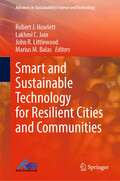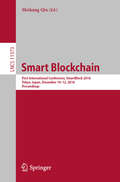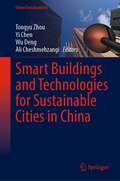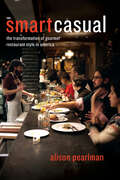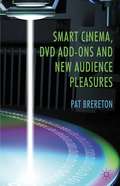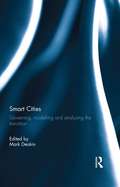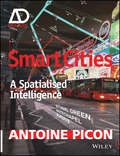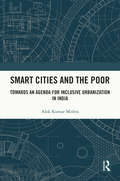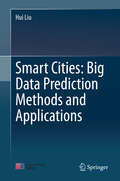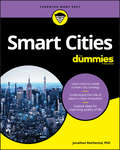- Table View
- List View
Smart and Sustainable Technology for Resilient Cities and Communities (Advances in Sustainability Science and Technology)
by Lakhmi C. Jain Robert J. Howlett John R. Littlewood Marius M. BalasThis book is a collection of extended versions of papers presented at the KES Covid-19 Challenge international summit. The book focusses on technological, economic, and social developments to combat the effects of global and local disasters as well as the ways in which the recovery from Covid can be used to build more resilient and sustainable communities, industry, and improve the environment. It also discusses the global challenges of human-influenced climate change. There are chapters on making cities and communities more resilient through energy self-sufficiency, food production, resilient housing and buildings, human health and intelligent systems e.g. for forecasting and prediction.
Smart Architecture – A Sustainable Approach for Transparent Building Components Design
by Valentina FrighiThis book explores the specific role that glazing technologies play within the world of smart architecture as important components of contemporary and future sustainable architectural and technological research. Smart Architecture begins with a definition of the concept of “smart” in architecture and examines how innovative technologies and materials have shaped buildings over the years. The author then provides a supporting database of contemporary smart architecture—mapping adopted strategies, recognizing common patterns, and evaluating current and future trends in the context of smart building envelopes, energy efficiency, and the development of high-potential innovative building components. The book proceeds with a focus on the specific role that glazing technologies play in this framework and provides a systematic methodology to quantify options for the effective integration of transparent building components within advanced and innovative building envelope systems.
Smart Blockchain: First International Conference, SmartBlock 2018, Tokyo, Japan, December 10–12, 2018, Proceedings (Lecture Notes in Computer Science #11373)
by Meikang QiuThis book constitutes the refereed proceedings of the First International Conference on Smart Blockchain, SmartBlock 2018, held in Tokyo, Japan, in December 2018. The 17 papers presented in this volume were carefully reviewed and selected from 102 submissions. They focus on a broad range of topics in the area of blockchain, from privacy-preserving solutions to designing advanced blockchain mechanism, from empirical studies to practical manuals.
Smart Buildings: Technology and the Design of the Built Environment
by Ron BakkerHow is technology shaping our built environment and changing the practice of architecture? This book explores how buildings and spaces are designed, built, used, and better understood through technology. A practical guide to technical advances including Internet of Things (IoT), 3D printing, innovative materials and robotics, Smart Buildings also outlines the opportunities for architecture including improved communication, flexibility, wellbeing, productivity and data collection. Bringing together multidisciplinary contributions and case studies from across the globe, this book provides an inspiring practical guide on how technology can inspire new architectural ideas, improving quality, comfort, health and wellbeing in the built environment
Smart Buildings: Technology and the Design of the Built Environment
by Ron BakkerHow is technology shaping our built environment and changing the practice of architecture? This book explores how buildings and spaces are designed, built, used, and better understood through technology. A practical guide to technical advances including Internet of Things (IoT), 3D printing, innovative materials and robotics, Smart Buildings also outlines the opportunities for architecture including improved communication, flexibility, wellbeing, productivity and data collection. Bringing together multidisciplinary contributions and case studies from across the globe, this book provides an inspiring practical guide on how technology can inspire new architectural ideas, improving quality, comfort, health and wellbeing in the built environment
Smart Buildings and Technologies for Sustainable Cities in China (Urban Sustainability)
by Tongyu Zhou Yi Chen Wu Deng Ali CheshmehzangiThis book brings together the insights from professional associations who involved in developing relevant national standards in China, domestic and international scholars who are dedicated to research in related fields, and industry practitioners who have the most hands-on experience. Synthesizing their perspectives, this book discusses the advanced technologies that can meet the requirements for energy efficiency, building performance monitoring and management, and user-centric building services, which are considered the essential components for achieving sustainable and smart cities. Moreover, it provides reflections on the implementation of smart technologies and strategies in practice.
Smart Casual: The Transformation of Gourmet Restaurant Style in America
by Alison PearlmanFine dining and the accolades of Michelin stars once meant chandeliers, white tablecloths, and suited waiters with elegant accents. The stuffy attitude and often scant portions were the punchlines of sitcom jokes—it was unthinkable that a gourmet chef would stoop to plate a burger or a taco in his kitchen. And yet today many of us will queue up for a seat at a loud, crowded noodle bar or eagerly seek out that farm-to-table restaurant where not only the burgers and fries are organic but the ketchup is homemade—but it’s not just us: the critics will be there too, ready to award distinction. Haute has blurred with homey cuisine in the last few decades, but how did this radical change happen, and what does it say about current attitudes toward taste? Here with the answers is food writer Alison Pearlman. In Smart Casual: The Transformation of Gourmet Restaurant Style in America, Pearlman investigates what she identifies as the increasing informality in the design of contemporary American restaurants. By design, Pearlman does not just mean architecture. Her argument is more expansive—she is as interested in the style and presentation of food, the business plan, and the marketing of chefs as she is in the restaurant’s floor plan or menu design. Pearlman takes us hungrily inside the kitchens and dining rooms of restaurants coast to coast—from David Chang’s Momofuku noodle bar in New York to the seasonal, French-inspired cuisine of Alice Waters and Thomas Keller in California to the deconstructed comfort food of Homaro Cantu’s Moto in Chicago—to explore the different forms and flavors this casualization is taking. Smart Casual examines the assumed correlation between taste and social status, and argues that recent upsets to these distinctions have given rise to a new idea of sophistication, one that champions the omnivorous. The boundaries between high and low have been made flexible due to our desire to eat everything, try everything, and do so in a convivial setting. Through lively on-the-scene observation and interviews with major players and chefs, Smart Casual will transport readers to restaurants around the country to learn the secrets to their success and popularity. It is certain to give foodies and restaurant-goers something delectable to chew on.
Smart Casual: The Transformation of Gourmet Restaurant Style in America
by Alison PearlmanFine dining and the accolades of Michelin stars once meant chandeliers, white tablecloths, and suited waiters with elegant accents. The stuffy attitude and often scant portions were the punchlines of sitcom jokes—it was unthinkable that a gourmet chef would stoop to plate a burger or a taco in his kitchen. And yet today many of us will queue up for a seat at a loud, crowded noodle bar or eagerly seek out that farm-to-table restaurant where not only the burgers and fries are organic but the ketchup is homemade—but it’s not just us: the critics will be there too, ready to award distinction. Haute has blurred with homey cuisine in the last few decades, but how did this radical change happen, and what does it say about current attitudes toward taste? Here with the answers is food writer Alison Pearlman. In Smart Casual: The Transformation of Gourmet Restaurant Style in America, Pearlman investigates what she identifies as the increasing informality in the design of contemporary American restaurants. By design, Pearlman does not just mean architecture. Her argument is more expansive—she is as interested in the style and presentation of food, the business plan, and the marketing of chefs as she is in the restaurant’s floor plan or menu design. Pearlman takes us hungrily inside the kitchens and dining rooms of restaurants coast to coast—from David Chang’s Momofuku noodle bar in New York to the seasonal, French-inspired cuisine of Alice Waters and Thomas Keller in California to the deconstructed comfort food of Homaro Cantu’s Moto in Chicago—to explore the different forms and flavors this casualization is taking. Smart Casual examines the assumed correlation between taste and social status, and argues that recent upsets to these distinctions have given rise to a new idea of sophistication, one that champions the omnivorous. The boundaries between high and low have been made flexible due to our desire to eat everything, try everything, and do so in a convivial setting. Through lively on-the-scene observation and interviews with major players and chefs, Smart Casual will transport readers to restaurants around the country to learn the secrets to their success and popularity. It is certain to give foodies and restaurant-goers something delectable to chew on.
Smart Casual: The Transformation of Gourmet Restaurant Style in America
by Alison PearlmanFine dining and the accolades of Michelin stars once meant chandeliers, white tablecloths, and suited waiters with elegant accents. The stuffy attitude and often scant portions were the punchlines of sitcom jokes—it was unthinkable that a gourmet chef would stoop to plate a burger or a taco in his kitchen. And yet today many of us will queue up for a seat at a loud, crowded noodle bar or eagerly seek out that farm-to-table restaurant where not only the burgers and fries are organic but the ketchup is homemade—but it’s not just us: the critics will be there too, ready to award distinction. Haute has blurred with homey cuisine in the last few decades, but how did this radical change happen, and what does it say about current attitudes toward taste? Here with the answers is food writer Alison Pearlman. In Smart Casual: The Transformation of Gourmet Restaurant Style in America, Pearlman investigates what she identifies as the increasing informality in the design of contemporary American restaurants. By design, Pearlman does not just mean architecture. Her argument is more expansive—she is as interested in the style and presentation of food, the business plan, and the marketing of chefs as she is in the restaurant’s floor plan or menu design. Pearlman takes us hungrily inside the kitchens and dining rooms of restaurants coast to coast—from David Chang’s Momofuku noodle bar in New York to the seasonal, French-inspired cuisine of Alice Waters and Thomas Keller in California to the deconstructed comfort food of Homaro Cantu’s Moto in Chicago—to explore the different forms and flavors this casualization is taking. Smart Casual examines the assumed correlation between taste and social status, and argues that recent upsets to these distinctions have given rise to a new idea of sophistication, one that champions the omnivorous. The boundaries between high and low have been made flexible due to our desire to eat everything, try everything, and do so in a convivial setting. Through lively on-the-scene observation and interviews with major players and chefs, Smart Casual will transport readers to restaurants around the country to learn the secrets to their success and popularity. It is certain to give foodies and restaurant-goers something delectable to chew on.
Smart Casual: The Transformation of Gourmet Restaurant Style in America
by Alison PearlmanFine dining and the accolades of Michelin stars once meant chandeliers, white tablecloths, and suited waiters with elegant accents. The stuffy attitude and often scant portions were the punchlines of sitcom jokes—it was unthinkable that a gourmet chef would stoop to plate a burger or a taco in his kitchen. And yet today many of us will queue up for a seat at a loud, crowded noodle bar or eagerly seek out that farm-to-table restaurant where not only the burgers and fries are organic but the ketchup is homemade—but it’s not just us: the critics will be there too, ready to award distinction. Haute has blurred with homey cuisine in the last few decades, but how did this radical change happen, and what does it say about current attitudes toward taste? Here with the answers is food writer Alison Pearlman. In Smart Casual: The Transformation of Gourmet Restaurant Style in America, Pearlman investigates what she identifies as the increasing informality in the design of contemporary American restaurants. By design, Pearlman does not just mean architecture. Her argument is more expansive—she is as interested in the style and presentation of food, the business plan, and the marketing of chefs as she is in the restaurant’s floor plan or menu design. Pearlman takes us hungrily inside the kitchens and dining rooms of restaurants coast to coast—from David Chang’s Momofuku noodle bar in New York to the seasonal, French-inspired cuisine of Alice Waters and Thomas Keller in California to the deconstructed comfort food of Homaro Cantu’s Moto in Chicago—to explore the different forms and flavors this casualization is taking. Smart Casual examines the assumed correlation between taste and social status, and argues that recent upsets to these distinctions have given rise to a new idea of sophistication, one that champions the omnivorous. The boundaries between high and low have been made flexible due to our desire to eat everything, try everything, and do so in a convivial setting. Through lively on-the-scene observation and interviews with major players and chefs, Smart Casual will transport readers to restaurants around the country to learn the secrets to their success and popularity. It is certain to give foodies and restaurant-goers something delectable to chew on.
Smart Casual: The Transformation of Gourmet Restaurant Style in America
by Alison PearlmanFine dining and the accolades of Michelin stars once meant chandeliers, white tablecloths, and suited waiters with elegant accents. The stuffy attitude and often scant portions were the punchlines of sitcom jokes—it was unthinkable that a gourmet chef would stoop to plate a burger or a taco in his kitchen. And yet today many of us will queue up for a seat at a loud, crowded noodle bar or eagerly seek out that farm-to-table restaurant where not only the burgers and fries are organic but the ketchup is homemade—but it’s not just us: the critics will be there too, ready to award distinction. Haute has blurred with homey cuisine in the last few decades, but how did this radical change happen, and what does it say about current attitudes toward taste? Here with the answers is food writer Alison Pearlman. In Smart Casual: The Transformation of Gourmet Restaurant Style in America, Pearlman investigates what she identifies as the increasing informality in the design of contemporary American restaurants. By design, Pearlman does not just mean architecture. Her argument is more expansive—she is as interested in the style and presentation of food, the business plan, and the marketing of chefs as she is in the restaurant’s floor plan or menu design. Pearlman takes us hungrily inside the kitchens and dining rooms of restaurants coast to coast—from David Chang’s Momofuku noodle bar in New York to the seasonal, French-inspired cuisine of Alice Waters and Thomas Keller in California to the deconstructed comfort food of Homaro Cantu’s Moto in Chicago—to explore the different forms and flavors this casualization is taking. Smart Casual examines the assumed correlation between taste and social status, and argues that recent upsets to these distinctions have given rise to a new idea of sophistication, one that champions the omnivorous. The boundaries between high and low have been made flexible due to our desire to eat everything, try everything, and do so in a convivial setting. Through lively on-the-scene observation and interviews with major players and chefs, Smart Casual will transport readers to restaurants around the country to learn the secrets to their success and popularity. It is certain to give foodies and restaurant-goers something delectable to chew on.
Smart Casual: The Transformation of Gourmet Restaurant Style in America
by Alison PearlmanFine dining and the accolades of Michelin stars once meant chandeliers, white tablecloths, and suited waiters with elegant accents. The stuffy attitude and often scant portions were the punchlines of sitcom jokes—it was unthinkable that a gourmet chef would stoop to plate a burger or a taco in his kitchen. And yet today many of us will queue up for a seat at a loud, crowded noodle bar or eagerly seek out that farm-to-table restaurant where not only the burgers and fries are organic but the ketchup is homemade—but it’s not just us: the critics will be there too, ready to award distinction. Haute has blurred with homey cuisine in the last few decades, but how did this radical change happen, and what does it say about current attitudes toward taste? Here with the answers is food writer Alison Pearlman. In Smart Casual: The Transformation of Gourmet Restaurant Style in America, Pearlman investigates what she identifies as the increasing informality in the design of contemporary American restaurants. By design, Pearlman does not just mean architecture. Her argument is more expansive—she is as interested in the style and presentation of food, the business plan, and the marketing of chefs as she is in the restaurant’s floor plan or menu design. Pearlman takes us hungrily inside the kitchens and dining rooms of restaurants coast to coast—from David Chang’s Momofuku noodle bar in New York to the seasonal, French-inspired cuisine of Alice Waters and Thomas Keller in California to the deconstructed comfort food of Homaro Cantu’s Moto in Chicago—to explore the different forms and flavors this casualization is taking. Smart Casual examines the assumed correlation between taste and social status, and argues that recent upsets to these distinctions have given rise to a new idea of sophistication, one that champions the omnivorous. The boundaries between high and low have been made flexible due to our desire to eat everything, try everything, and do so in a convivial setting. Through lively on-the-scene observation and interviews with major players and chefs, Smart Casual will transport readers to restaurants around the country to learn the secrets to their success and popularity. It is certain to give foodies and restaurant-goers something delectable to chew on.
Smart Cinema, DVD Add-Ons and New Audience Pleasures
by P. BreretonExamining post-1990s Indie cinema alongside more mainstream films, Brereton explores the emergence of smart independent sensibility and how films break the classic linear narratives that have defined Hollywood and its alternative 'art' cinema. The work explores how bonus features on contemporary smart films speak to new generational audiences.
Smart Cities: Innovations, Challenges and Future Perspectives (S.M.A.R.T. Environments)
by Leonidas G. Anthopoulos Sushobhan Majumdar Vinay KandpalThis book aims to integrate new technologies and adaptation tools into the process of smart city planning. It also emphasizes the value and importance of modern technologies such as IoT and data science as a smart technology for the formation of a smart city. The authors believe that various technologies in a smart city will reduce all the problems for the sustainable growth and future prospects of the city. The first section of this book discusses the innovation of new technologies (AI, data science, block chain, etc.) that has flourished in recent decades which will make the city smarter. This section also describes that block chain and IoT (Internet of Things) are two transformative technologies that can greatly impact smart cities by enhancing security, improving transparency, and enabling efficient management of resources. The second section of the book explains about the uses of AI tools and smart technologies (like waste management, public safety and security) for the development and management of smart cities. This chapter also describes AI-powered systems that are integrated into smart buildings to optimize energy usage, enhance occupant comfort, and improve building management. These systems can adjust lighting and HVAC settings based on occupancy, learn user preferences, and provide personalized energy efficiency recommendations. The third portion of the book investigates the recent challenges and barriers of smart city that have been faced by the smart cities in the recent decades. This section also describes various challenges and barriers for the implementation of IoT sensor, AI technologies, etc., for the formation of a smart city. The future prospects of a smart city are the main theme of the last chapter. In this section, an attempt has been made about the future vision and outlook of the smart city. This chapter also describes different approaches (like smart grid, societal smart city, smart city model, etc.) for the future planning and management of the city.
Smart Cities: Governing, Modelling and Analysing the Transition
by Mark DeakinSmart city development has emerged a major issue over the past 5 years. Since the launch of IBM’s Smart Planet and CISCO’s Smart Cities and Communities programmes, their potential to deliver on global sustainable development targets have captured the public’s attention. However, despite this growing interest in the development of smart cities, little has as yet been published that either sets out the state-of-the-art, or which offers a less than subjective, arm’s length and dispassionate account of their potential contribution. This book brings together cutting edge research and the findings from technical development projects from leading authorities within the field to capture the transition to smart cities. It explores what is understood about smart cities, playing particular attention on the governance, modelling and analysis of the transition that smart cities seek to represent. In paving the way for such a representation, the book begins to account for the social capital of smart communities and begins the task of modelling their embedded intelligence through an analysis of what the "embedded intelligence of smart cities" contributes to the sustainability of urban development. This innovative book offers an interdisciplinary perspective and shall be of interest to researchers, policy analysts and technical experts involved in and responsible for the planning, development and design of smart cities. It will also be of particular value to final year undergraduate and postgraduate students interested in Geography, Architecture and Planning.
Smart Cities: Governing, Modelling and Analysing the Transition
by Mark DeakinSmart city development has emerged a major issue over the past 5 years. Since the launch of IBM’s Smart Planet and CISCO’s Smart Cities and Communities programmes, their potential to deliver on global sustainable development targets have captured the public’s attention. However, despite this growing interest in the development of smart cities, little has as yet been published that either sets out the state-of-the-art, or which offers a less than subjective, arm’s length and dispassionate account of their potential contribution. This book brings together cutting edge research and the findings from technical development projects from leading authorities within the field to capture the transition to smart cities. It explores what is understood about smart cities, playing particular attention on the governance, modelling and analysis of the transition that smart cities seek to represent. In paving the way for such a representation, the book begins to account for the social capital of smart communities and begins the task of modelling their embedded intelligence through an analysis of what the "embedded intelligence of smart cities" contributes to the sustainability of urban development. This innovative book offers an interdisciplinary perspective and shall be of interest to researchers, policy analysts and technical experts involved in and responsible for the planning, development and design of smart cities. It will also be of particular value to final year undergraduate and postgraduate students interested in Geography, Architecture and Planning.
Smart Cities: A Spatialised Intelligence (Architectural Design Primer)
by Antoine PiconAs cities compete globally, the Smart City has been touted as the important new strategic driver for regeneration and growth. Smart Cities are employing information and communication technologies in the quest for sustainable economic development and the fostering of new forms of collective life. This has made the Smart City an essential focus for engineers, architects, urban designers, urban planners, and politicians, as well as businesses such as CISCO, IBM and Siemens. Despite its broad appeal, few comprehensive books have been devoted to the subject so far, and even fewer have tried to relate it to cultural issues and to assume a truly critical stance by trying to decipher its consequences on urban space and experience. This cultural and critical lens is all the more important as the Smart City is as much an ideal permeated by Utopian beliefs as a concrete process of urban transformation. This ideal possesses a strong self-fulfilling character: our cities will become ‘Smart’ because we want them to. This book opens with an examination of the technological reality on which Smart Cities are built, from the chips and sensors that enable us to monitor what happens within the infrastructure to the smartphones that connect individuals. Through these technologies, the urban space appears as activated, almost sentient. This activation generates two contrasting visions: on the one hand, a neo-cybernetic ambition to steer the city in the most efficient way; and on the other, a more bottom-up, participative approach in which empowered individuals invent new modes of cooperation. A thorough analysis of these two trends reveals them to be complementary. The Smart City of the near future will result from their mutual adjustment. In this process, urban space plays a decisive role. Smart Cities are contemporary with a ‘spatial turn’ of the digital. Based on key technological developments like geo-localisation and augmented reality, the rising importance of space explains the strategic role of mapping in the evolution of the urban experience. Throughout this exploration of some of the key dimensions of the Smart City, this book constantly moves from the technological to the spatial as well as from a critical assessment of existing experiments to speculations on the rise of a new form of collective intelligence. In the future, cities will become smarter in a much more literal way than what is often currently assumed.
Smart Cities: A Spatialised Intelligence (Architectural Design Primer)
by Antoine PiconAs cities compete globally, the Smart City has been touted as the important new strategic driver for regeneration and growth. Smart Cities are employing information and communication technologies in the quest for sustainable economic development and the fostering of new forms of collective life. This has made the Smart City an essential focus for engineers, architects, urban designers, urban planners, and politicians, as well as businesses such as CISCO, IBM and Siemens. Despite its broad appeal, few comprehensive books have been devoted to the subject so far, and even fewer have tried to relate it to cultural issues and to assume a truly critical stance by trying to decipher its consequences on urban space and experience. This cultural and critical lens is all the more important as the Smart City is as much an ideal permeated by Utopian beliefs as a concrete process of urban transformation. This ideal possesses a strong self-fulfilling character: our cities will become ‘Smart’ because we want them to. This book opens with an examination of the technological reality on which Smart Cities are built, from the chips and sensors that enable us to monitor what happens within the infrastructure to the smartphones that connect individuals. Through these technologies, the urban space appears as activated, almost sentient. This activation generates two contrasting visions: on the one hand, a neo-cybernetic ambition to steer the city in the most efficient way; and on the other, a more bottom-up, participative approach in which empowered individuals invent new modes of cooperation. A thorough analysis of these two trends reveals them to be complementary. The Smart City of the near future will result from their mutual adjustment. In this process, urban space plays a decisive role. Smart Cities are contemporary with a ‘spatial turn’ of the digital. Based on key technological developments like geo-localisation and augmented reality, the rising importance of space explains the strategic role of mapping in the evolution of the urban experience. Throughout this exploration of some of the key dimensions of the Smart City, this book constantly moves from the technological to the spatial as well as from a critical assessment of existing experiments to speculations on the rise of a new form of collective intelligence. In the future, cities will become smarter in a much more literal way than what is often currently assumed.
Smart Cities: Lock-in, Path-dependence and Non-linearity of Digitalization and Smartification (Advances In Science, Technology And Innovation Ser.)
by Anna Visvizi Hanna Godlewska-MajkowskaThis book seeks to identify and to examine factors and mechanisms underlying the growth and development of smart cities.It is commonplace to discuss smart cities through the lens of advances in ICT. The resulting overemphasis on what is technologically possible downplays what is politically, socially and economically feasible. This book, by analysing the smart city through a variety of perspectives, offers a more comprehensive insight into and understanding of the complex and the open-ended nature of the growth and development of a smart city. A solid conceptual framework is developed and employed throughout the chapters, and a selection of case studies from Europe, Asia, and the Arab Peninsula grants the readers a hands-on perspective of the matters discussed.The chapters included in this book address a set of questions, including: How do the twin-processes of digitalization and smartification unfold in the context of the smart city agenda? How do these processes relate to the concepts of smart city 1.0, 2.0., 3.0. and 4.0? In which ways have the spatial aspects of city functioning been influenced by the intrusion of ICT? In which ways do the same processes contribute to the attainment of the UN Sustainable Development Goals (SDGs)? What are the implications of smartification and the emergence of smart organizations (public, private, and voluntary) for the spatial development of smart cities? Do ICT and its application in the city space boost the processes of revitalization and how does ICT influence the process of gentrification? To what extent and how does the intrusion of ICT-enhanced tools and applications in the city space impact on a city’s relationship with its broader territorially defined context? Are the administrative borders and divisions inherent in the fabric of a city becoming less/more porous? How should urban sprawl be conceived in the context of the smart city debate? This book will have a broad appeal to academics, students, and policy makers with interests in urban planning, sustainable development, cities, economics, technology, sociology, urban studies, digitalization, SDGs, wellbeing, and resilience.
Smart Cities: Lock-in, Path-dependence and Non-linearity of Digitalization and Smartification
This book seeks to identify and to examine factors and mechanisms underlying the growth and development of smart cities.It is commonplace to discuss smart cities through the lens of advances in ICT. The resulting overemphasis on what is technologically possible downplays what is politically, socially and economically feasible. This book, by analysing the smart city through a variety of perspectives, offers a more comprehensive insight into and understanding of the complex and the open-ended nature of the growth and development of a smart city. A solid conceptual framework is developed and employed throughout the chapters, and a selection of case studies from Europe, Asia, and the Arab Peninsula grants the readers a hands-on perspective of the matters discussed.The chapters included in this book address a set of questions, including: How do the twin-processes of digitalization and smartification unfold in the context of the smart city agenda? How do these processes relate to the concepts of smart city 1.0, 2.0., 3.0. and 4.0? In which ways have the spatial aspects of city functioning been influenced by the intrusion of ICT? In which ways do the same processes contribute to the attainment of the UN Sustainable Development Goals (SDGs)? What are the implications of smartification and the emergence of smart organizations (public, private, and voluntary) for the spatial development of smart cities? Do ICT and its application in the city space boost the processes of revitalization and how does ICT influence the process of gentrification? To what extent and how does the intrusion of ICT-enhanced tools and applications in the city space impact on a city’s relationship with its broader territorially defined context? Are the administrative borders and divisions inherent in the fabric of a city becoming less/more porous? How should urban sprawl be conceived in the context of the smart city debate? This book will have a broad appeal to academics, students, and policy makers with interests in urban planning, sustainable development, cities, economics, technology, sociology, urban studies, digitalization, SDGs, wellbeing, and resilience.
Smart Cities and the Poor: Towards an Agenda for Inclusive Urbanization in India
by Alok MishraDeveloping countries worldwide have been embarking on ‘smart cities’ programmes using new technology solutions to improve public services. Faced with severe problems of digital divide, poverty, unemployment, inequality, and financial and social exclusion, these cities have to negotiate hard in order to reach their goals. This book examines urban governance, digital divide, poverty, unemployment, and financial and social exclusion and presents a theoretical perspective on inclusive cities, urbanization, migration, slums,and affordable housing.The book aims at formulating and implementing an agenda for inclusive, equitable, and sustainable urban development in tune with the UN-SDGs, the New Urban Agenda of Habitat III, and India’s new national urban missions. It probes into the scope of adopting inclusionary urban planning, zoning, and housing, financing inclusive city development, and poverty alleviation through municipal finance reforms using findings and lessons from detailed field studies of Indian cities. It also suggests an agenda for slum-free and poverty-free cities in an attempt to make these cities more people-focused, humane, and inclusionary.This book will be of interest to scholars and researchers of political science, policy studies, public administration, urban studies, urban planning and management, urban sociology, and geography, besides being of interest to policy researchers, community workers, grass roots researchers, policymakers, and sociologists.
Smart Cities and the Poor: Towards an Agenda for Inclusive Urbanization in India
by Alok MishraDeveloping countries worldwide have been embarking on ‘smart cities’ programmes using new technology solutions to improve public services. Faced with severe problems of digital divide, poverty, unemployment, inequality, and financial and social exclusion, these cities have to negotiate hard in order to reach their goals. This book examines urban governance, digital divide, poverty, unemployment, and financial and social exclusion and presents a theoretical perspective on inclusive cities, urbanization, migration, slums,and affordable housing.The book aims at formulating and implementing an agenda for inclusive, equitable, and sustainable urban development in tune with the UN-SDGs, the New Urban Agenda of Habitat III, and India’s new national urban missions. It probes into the scope of adopting inclusionary urban planning, zoning, and housing, financing inclusive city development, and poverty alleviation through municipal finance reforms using findings and lessons from detailed field studies of Indian cities. It also suggests an agenda for slum-free and poverty-free cities in an attempt to make these cities more people-focused, humane, and inclusionary.This book will be of interest to scholars and researchers of political science, policy studies, public administration, urban studies, urban planning and management, urban sociology, and geography, besides being of interest to policy researchers, community workers, grass roots researchers, policymakers, and sociologists.
Smart Cities: Big Data Prediction Methods and Applications
by Hui LiuSmart Cities: Big Data Prediction Methods and Applications is the first reference to provide a comprehensive overview of smart cities with the latest big data predicting techniques. This timely book discusses big data forecasting for smart cities. It introduces big data forecasting techniques for the key aspects (e.g., traffic, environment, building energy, green grid, etc.) of smart cities, and explores three key areas that can be improved using big data prediction: grid energy, road traffic networks and environmental health in smart cities. The big data prediction methods proposed in this book are highly significant in terms of the planning, construction, management, control and development of green and smart cities. Including numerous case studies to explain each method and model, this easy-to-understand book appeals to scientists, engineers, college students, postgraduates, teachers and managers from various fields of artificial intelligence, smart cities, smart grid, intelligent traffic systems, intelligent environments and big data computing.
Smart Cities For Dummies
by ReichentalBecome empowered to build and maintain smarter cities At its core, a Smart City is a collection of technological responses to the growing demands, challenges, and complexities of improving the quality of life for billions of people now living in urban centers across the world. The movement to create smarter cities is still in its infancy, but ambitious and creative projects in all types of cities—big and small—around the globe are beginning to make a big difference. New ideas, powered by technology, are positively changing how we move humans and products from one place to another; create and distribute energy; manage waste; combat the climate crisis; build more energy efficient buildings; and improve basic city services through digitalization and the smart use of data. Inside this book you’ll find out: What it really means to create smarter cities How our urban environments are being transformed Big ideas for improving the quality of life for communities Guidance on how to create a smart city strategy The essential role of data in building better cities The major new technologies ready to make a difference in every community Smart Cities will give you the knowledge to understand this important topic in depth and be ready to be an agent of change in your community.
Smart Cities For Dummies
by ReichentalBecome empowered to build and maintain smarter cities At its core, a Smart City is a collection of technological responses to the growing demands, challenges, and complexities of improving the quality of life for billions of people now living in urban centers across the world. The movement to create smarter cities is still in its infancy, but ambitious and creative projects in all types of cities—big and small—around the globe are beginning to make a big difference. New ideas, powered by technology, are positively changing how we move humans and products from one place to another; create and distribute energy; manage waste; combat the climate crisis; build more energy efficient buildings; and improve basic city services through digitalization and the smart use of data. Inside this book you’ll find out: What it really means to create smarter cities How our urban environments are being transformed Big ideas for improving the quality of life for communities Guidance on how to create a smart city strategy The essential role of data in building better cities The major new technologies ready to make a difference in every community Smart Cities will give you the knowledge to understand this important topic in depth and be ready to be an agent of change in your community.
